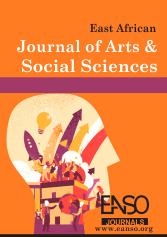Cost-effectiveness of Implementing E-government Strategies in Customs Clearance at Julius Nyerere International Airport in Tanzania
Abstract
Digital transformation in customs clearance processes represents a critical shift in how governments modernize international trade operations and border control procedures. Thus, the current study examined the cost-effectiveness of implementing e-government strategies in customs clearance at Julius Kambarage Nyerere International Airport (JNIA). A qualitative research approach was employed for this study, whereby, a sample size of 26 respondents, including customs officials, airport management, traders, and passengers were subjected to interview questions. Primary tools for data collection included interviews and observations. Study findings established that e-government strategies impacted time efficiency in customs clearance. Herein, it was found that faster processing times have resulted in cost savings and as well increased revenues for JNIA in the customs department. Also, the findings revealed that there was an improvement in accuracy and fraud detection resulting from e-government systems. Denoting that automated checks within the system have allowed for immediate identification of inconsistencies and discrepancies, which were previously more challenging to detect with manual systems. Based on these foregoing findings, this study recommends that policymakers should address the occasional bottlenecks identified during the study, it is recommended that JNIA implement regular system maintenance and upgrades to minimize system downtime as well as ensure continuous training for customs officials on the use of e-government systems should be a priority
Downloads
References
Al-Khouri, A. M. (2022). eGovernment strategies the case of the United Arab Emirates (UAE). European Journal of ePractice, 17 (September), 126-150.
Amanbek, Y. (2020). Adoption of e-Government in the Republic of Kazakhstan. Journal of Open Innovation, Technology, Market, and Complexity, 46.
Basu, S. (2020). E‐government and developing countries: an overview. International Review of Law, Computers & Technology, 18(1), 109-132.
Dahi, M., & Ezziane, Z. (2015). Measuring e-government adoption in Abu Dhabi with technology acceptance model (TAM). International Journal of Electronic Governance, 7(3), 206-231.
Jaffer, S., & Timbrell, G. (2018). Digital strategy in airports. In Proceedings of the 25th Australasian Conference on Information Systems (pp. 1-11). Auckland: ACIS/Auckland University of Technology.
Odago, Z. O., Bonuke, R., & Nekesa, M. (2021). Effect of adoption of electronic cargo tracking system on excise revenue collection in Kenya: a case of Jomo Kenyatta International Airport. Nairobi: MOI UNIVERSITY.
Osei‐Kojo, A. (2017). E‐government and public service quality in Ghana. Journal of Public Affairs, 17(3), e1620.
Rafique, H., Almagrabi, A. O., Shamim, A., Anwar, F., & Bashir, A. K. (2020). Investigating the acceptance of mobile library applications with an extended technology acceptance model (TAM). Computers & Education, 145, 103732.
Ramadhan, A. H., & Muigai, R. G. (2016). Factors influencing implementation of ICT projects in Kenya Airports Authority. International Journal of Innovative Research and Advanced Studies, 3(10).
Riany, K. G. (2021). Influence of e-government strategies on public service delivery of state agencies in Kenya: The moderating effect of strategy execution (Doctoral dissertation, JKUAT-COHRED).
Thums, J., Künzel, L., Klumpp, M., Bardmann, M. M., & Ruiner, C. (2023). Future air transportation and digital work at airports–Review and developments. Transportation Research Interdisciplinary Perspectives, 19, 100808.
Yusuf, H. M. (2016). Limitations of E-Government Adoption by Local Governments: A Case Study of Ilala Municipal Council, Tanzania. Information and Knowledge Management, 6(2), 34-39.
Copyright (c) 2025 Solomon Simon Mhango, PhD, Mwisi Kongo Zoma

This work is licensed under a Creative Commons Attribution 4.0 International License.




























